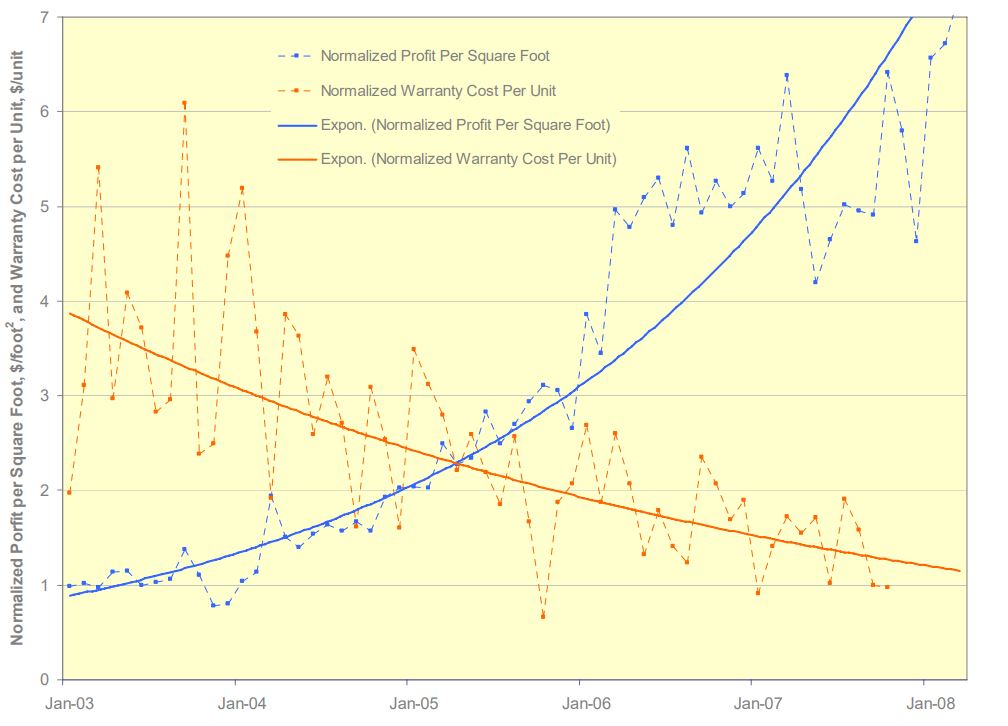Archive for the ‘How To’ Category
Resurrecting Manufacturing Through Product Simplification
Product simplification can radically improve profits and radically improve product robustness. Here’s a graph of profit per square foot ($/ft^2) which improved by a factor of seven and warranty cost per unit ($/unit), a measure of product robustness), which improved by a factor of four. The improvements are measured against the baseline data of the legacy product which was replaced by the simplified product. Design for Assembly (DFA) was used to simplify the product and Robust Design methods were used to reduce warranty cost per unit.

I will go on record that everyone will notice when profit per square foot increases by a factor of seven.
And I will also go on record that no one will believe you when you predict product simplification will radically improve profit per square foot.
And I will go on record that when warranty cost per unit is radically reduced, customers will notice. Simply put, the product doesn’t break and your customers love it.
But here’s the rub. The graph shows data over five years, which is a long time. And if the product development takes two years, that makes seven long years. And in today’s world, seven years is at least four too many. But take another look at the graph. Profit per square foot doubled in the first two years after launch. Two years isn’t too long to double profit per square foot. I don’t know of a faster way, More strongly, I don’t know of another way to get it done, regardless of the timeline.
I think your company would love to double the profit per square foot of its assembly area. And I’ve shown you the data that proves it’s possible. So, what’s in the way of giving it a try?
For the details about the work, here’s a link – Systematic DFMA Deployment, It Could Resurrect US Manufacturing.
Effectiveness Before Efficiency
 Efficient – How do we do more projects with fewer people?
Efficient – How do we do more projects with fewer people?
Effective – Let’s choose the right project.
Would you rather do more projects that miss the mark or fewer that excite the customer?
Efficient – How do we finish the project faster?
Effective – Let’s fully staff the project.
Would you rather burn out the project team or deliver on what the customer wants?
Efficient – How do we reduce product cost by 5%?
Effective – Let’s make customers’ lives easier.
Would you rather reduce the cost or delight the customer?
Efficient – How can we go faster?
Effective – Let’s get it right.
Would you rather go fast and break things or get it right for the customer?
Efficient – How many projects can we run in parallel?
Effective – Let’s fully staff the most important projects.
Would you rather get halfway through four projects or complete two?
Efficient – How do we make progress on as many tasks as possible?
Effective – Let’s work on the critical path.
Would you rather work on things that don’t matter or nail the things that do?
Efficient – How can we complete the most tasks?
Effective – Let’s work on the hardest thing first.
Would you rather learn the whole thing won’t work before or after you waste time on the irrelevant?
If there’s a choice between efficiency and effectiveness, I choose effectiveness.
Image credit — Antarctica Bound
When in doubt, start.
 At the start, it’s impossible to know the right thing to do, other than the right thing is to start.
At the start, it’s impossible to know the right thing to do, other than the right thing is to start.
If you think you should have started, but have not, the only thing in the way is you.
If you want to start, get out of your own way, and start.
And even if you’re not in the way, there’s no harm in declaring you ARE in the way and starting.
If you’re afraid, be afraid. And start.
If you’re not afraid, don’t be afraid. And start.
If you can’t choose among the options, all options are equally good. Choose one, and start.
If you’re worried the first thing won’t work, stop worrying, start starting, and find out.
Before starting, you don’t have to know the second thing to do. You only have to choose the first thing to do.
The first thing you do will not be perfect, but that’s the only path to the second thing that’s a little less not perfect.
The second thing is defined by the outcome of the first. Start the first to inform the second.
If you don’t have the bandwidth to start a good project, stop a bad one. Then, start.
If you stop more you can start more.
Starting small is a great way to start. And if you can’t do that, start smaller.
If you don’t start, you can never finish. That’s why starting is so important.
In the end, starting starts with starting. This is The Way.
Image credit — Claudio Marinangeli
What do you do when you’ve done it before?

COPYRIGHT GEOFF HENSON
If you’ve done it before, let someone else do it.
If you’ve done it before, teach someone else to do it.
If you’ve done it before, do it in a tenth of the time.
Do it differently just because you can.
Do it backward. That will make you smile.
Do it with your eyes closed. That will make a statement.
Do its natural extension. That could be fun.
Do the opposite. Then do its opposite. You’ll learn more.
Do what they should have asked for. Life is short.
Do what scares them. It’s sure to create new design space.
Do what obsoletes your most profitable offering. Wouldn’t you rather be the one to do it?
Do what scares you. That’s sure to be the most interesting of all.
Image credit — Geoff Henson
How To Be More Effective

Put it out there. You don’t have time to do otherwise.
Be true to yourself. No one deserves that more than you do.
Tell the truth, even when it’s difficult for people to hear. They’ll appreciate your honesty.
Believe the actions and not the words. Enough said.
Learn to listen to what is not said. That’s usually the juicy part.
Say no to good projects so you can say yes to great ones.
Say what you will do and do it. That’s where trust comes from.
Deliver praise in public. Better yet, deliver praise in front of their spouse.
Develop informal networks. They are more powerful than the formal org chart.
Learn to see what’s not happening. You’ll understand what’s truly going on.
Help people. It’s like helping yourself twice.
Don’t start a project you’re not committed to finishing. There’s no partial credit with projects.
Do the right thing, even if it comes at your expense.
And be your best self. Isn’t that what you do best?
Image credit — Tambako The Jaguar
The Importance of Moving From Telling to Asking
 Tell me what you want done, but don’t tell me how. You’ve got to leave something for me.
Tell me what you want done, but don’t tell me how. You’ve got to leave something for me.
Better yet, ask me to help you with a problem and let me solve it. I prefer asking over telling.
Better still, explain the situation and ask me what I think. We can then discuss why I see it the way I do and we can create an approach.
Even better, ask me to assess the situation and create a proposal.
Better still, ask me to assess the situation, create a project plan, and run the project.
If you come up with a solution but no definition of the problem, I will ask you to define the problem.
If you come up with a solution and a definition of the problem, I will ask you to explain why it’s the right solution.
If you come up with a problem, a solution, and an analysis that justifies the solution, I will ask why you need me.
If you know what you want to do, don’t withhold information and make me guess.
If you know what you want to do, ask me to help and I will help you with your plan.
If you know what you want to do and want to improve your plan, ask me how to make your plan better.
If you want your plan to become our plan, bring me in from the start and ask me what I think we should do.
Image credit — x1klima
Why Hardware Is Hard For Startups And What to Do About It
 Software may be eating the world, but the hardware elements of a startup’s work define when lunch is served.
Software may be eating the world, but the hardware elements of a startup’s work define when lunch is served.
Hardware takes longer than software. With hardware, after the product and its parts are designed, companies are vetted/selected to make the parts; contracts are signed to make the parts; the parts are made; the parts are shipped; the parts are received; the parts are inspected; and the parts are put in their locators. Then, the manufacturing process is defined, the manufacturing tooling is designed and purchased; the manufacturing documentation is created; the final test system is designed and built; and the parts are assembled into the product. Then, the product is run through final test and tested for robustness. After it’s learned the manufacturing process created too much variation and the insufficient robustness manifests, the manufacturing process and its documentation are changed to reduce variation; the parts that failed are redesigned, purchased, made, shipped, and received; and the next iteration of the product is built and tested. This process is repeated until the product is robust and the manufacturing process is repeatable. This is why hardware takes longer than software.
If the software is done but the hardware isn’t, the software must wait for the hardware and the customer must wait for the finished product. To get the hardware done faster, recognize that redesign loops are part of the game and invest in the capability to iterate quickly. Line up the suppliers to make parts quickly; keep utilization low on the support resources so they can jump on the work when it arises (think fire stations who can respond quickly when there’s a fire); and avoid part-time resources on the critical path. There may be other things to focus on, but only after taking care of these three.
Software may be eating the world, but the hardware elements of a startup’s work govern the cost of getting to the dinner table.
Hardware costs more to make than software. Hardware is made of steel, aluminum, injection molded plastics, and rare earth elements, all of which cost money. And because startups do things that have not been done before, the materials can be special (costly). And unlike software, the marginal cost of an incremental unit is non-zero. With hardware, if you want to make another one you’ve got to buy more of the materials; you have to pay people to make it; you have to buy/build the manufacturing system; you have to buy the measurement systems and engineering infrastructure; and you have to pay people to break-test-fix the product until it’s ready.
What’s a startup to do?
To do hardware faster, focus on learning. And to do hardware more cost-effectively, focus on learning.
For both time and money, learning efficiency is a good starting point. The most efficient learning is the learning you don’t have to do, so be ruthless in how you decide what you DON’T learn. Where possible, declare all but the most vital problems as annoyances and save them for later. (Annoyances don’t require learning.) This will concentrate your precious resources on fewer problems, improve your learning rate, and keep costs to a minimum.
Here’s a good test to decide if the learning is worth learning. Ask yourself “If we accomplish this learning objective, how will the customer benefit?” If there is low or no customer benefit, say no to the learning objective. If there is medium customer benefit, say no to the learning objective. If there is significant customer benefit, do the learning.
For those learning objectives that make it through the gauntlet, learn what you need to learn, but no more. To do this, create a formal learning objective: “We want to learn [enter learning objective here].” With learning objectives, the tighter the better. And define the criteria for decision making: “If the result of the test is [define objective measurement here], we will decide [enter decision here].” With decision criteria, the clearer the better.
Learn effectively, not elegantly. Be bold, rough, and crude with how you learn. Design tests that take advantage of the resources you have on hand so you can learn quickly. If you can run a crude test in one hour and the perfect test will take a week, run three crude tests and be done by the end of the day.
Learn with less confidence and more judgment. If a wrong decision can be overcome quickly and with low cost, be less confident and use more judgment.
Whether driven by hardware, software, or the integration of both, project completion is governed by the critical path. And with longer time constants, it’s more likely that the hardware defines the critical path. The total cost of the project is the sum of the three costs: software, hardware, and integration. And because hardware requires expensive materials, factories, engineering labs, people to run the tests, and people to make the products, hardware is likely a large percentage of the project costs.
Image credit — Günter Hentschel
Pro Tips for New Product Development Projects
 Do the project right or do the right project – which would you choose?
Do the project right or do the right project – which would you choose?
If you improve time to market, the only thing that improves is time to market. How do you feel about that?
Customers pay for things that make their lives easier. Time to market doesn’t do that.
There’s no partial credit with new product development projects. If the product isn’t 100% ready for sale, it’s 0% ready.
If you made 1/8th progress on 8 projects, you made zero progress. But you did consume valuable resources.
If you made 100% progress on one project, you made progress.
When you have too many projects, you get too few done.
If you don’t know how many projects your company has, you have too many.
Would you rather choose the right project and run it inefficiently or choose the wrong project and run it efficiently?
When you choose the wrong project but run it efficiently, that’s called efficient ineffectiveness.
You can save several weeks making sure you choose the right project by starting the project too soon and running the wrong one for two years.
If your projects are slow, it’s likely the support functions are too highly utilized. Add capacity to keep their peak utilization below 85%.
When shared resources are sized appropriately, they’re underutilized most of the time. Think fire station and firefighters – when there’s a fire they respond quickly, and when there’s no fire they improve their skills so they can fight the next one better than the last.
If your projects are slow, check to see if you have resources on the critical path that work part-time. Part-time resources support multiple projects and don’t work full-time on your project. And you can’t control when they work on your project. There’s no place for that on the critical path.
If you’re thinking about using part-time resources on the critical path, don’t.
Know where the novelty is and work that first. And before you can work on the novelty you’ve got to know where it is.
You can have too little novelty, meaning the new product is so much like the old one there’s no need to launch it. Mostly, though, projects have too much novelty.
If you are working on a clean-sheet design, there is no such thing. There are no green-field projects. All projects are brown-field projects. It’s just that some are browner than others.
Novelty generates problems and problems take three times longer to solve than anyone thinks. To reduce the number of problems, declare as many as possible as annoyances. Unlike problems, annoyances don’t have to be solved by the project. Remember, it’s okay to save some work for the next project.
Even though you have a product development process, that process is powered by people. People make it work and people make it not work. If you get one thing right, get the people part right.
Image credit – claudia gabriela marques
What’s a dinosaur to do?
 When you do something for a long time, the physical and mental muscles you exercise get stronger and you get better at that activity. But where the muscles you use get stronger, the ones you don’t use atrophy and you get worse at all the other things.
When you do something for a long time, the physical and mental muscles you exercise get stronger and you get better at that activity. But where the muscles you use get stronger, the ones you don’t use atrophy and you get worse at all the other things.
When you do something for a long time, people see you as someone who does that one thing. And because it’s easy for everyone, that same old work lands on your desk and the system reinforces the problem. The company knows it will get done quickly and well, and because you’ve done it before, it’s easy for you. But what’s good and easy in the short term may not be so good and easy in the long term. When you do what you did last time, you get stale and you don’t grow. It’s the same for your career. When they see only one slice of you, there’s a long-term downside
When you look at the same old problems for a long time, you see only the same old solutions. And more troubling, you’re blind to your blindness. If you’ve solved the same family of problems for the last decade, you won’t see the new solutions made possible by developments in new areas. And more troubling, you won’t see that it’s time to solve new problems because the same old problems find your desk.
What’s a dinosaur to do?
Pair up with a younger person who wants to learn and teach them how to solve problems. Their energy will rub off on you and your smarts will contaminate them. A fair trade for both. Teach them how to understand the situation as it is – both in the problem space and political space. Teach them how to read the tea leaves and hear what’s unsaid. You’ll learn you know far more than you thought and you’ll get to show your whole self to your younger partner in crime.
Put them in a position to succeed and take pride in their success. Give them credit and revel in their development. Help them stretch and protect them from breaking. Keep them safe and help them live dangerously. Provide air cover as only you can, and do it with plausible deniability. You will get great joy (and energy!) from this.
When you’re low on energy, help people. When you’re down in the dumps, take someone to lunch and listen to them. When you’re tired of the same old work, help people do new work. And when you want to feel good about what you know, teach people.
At this point in your career, you have all you need and plenty to spare. Ground yourself in your abundance and give it away. Everyone will be better for it, including you.
Image credit — Steve Walker
Credibility and Trust – a Powerful One-Two Punch – If You Build Them
 Credibility built – when the situation is not good, you say “the situation is not good.” And when things went poorly you say “things went poorly.”
Credibility built – when the situation is not good, you say “the situation is not good.” And when things went poorly you say “things went poorly.”
Trust built – when things go well you give away the credit.
Credibility built – when you provide a controversial perspective and three years later it turns out you were right.
Trust built – when you share your frustrations in confidence.
Credibility built – when you ground your argument in facts, especially inconvenient ones.
Trust built – when you say “I will keep that in confidence” and you do.
Credibility built – when you don’t know, you say “I don’t know.”
Trust built – when you do something that benefits others but comes at your own expense.
Credibility destroyed – when you tell people things are one way when they know it’s the other.
Trust destroyed – when you respond from a hardened heart.
Credibility destroyed – when you tell partial truths.
Trust destroyed – when you avoid doing the right thing.
Credibility and trust are a powerful one-two punch, but only if you build them.
Image credit — _Veit_
Resource Allocation IS Strategy
 In business, we have vision statements, mission statements, strategic plans, strategic initiatives, and operating plans. And every day there are there are countless decisions to make. But, in the end, it all comes down to one thing – how we allocate our resources. Whether it’s hiring people, training them, buying capital, or funding projects, all strategic decisions come back to resource allocation. Said more strongly, resource allocation is strategy.
In business, we have vision statements, mission statements, strategic plans, strategic initiatives, and operating plans. And every day there are there are countless decisions to make. But, in the end, it all comes down to one thing – how we allocate our resources. Whether it’s hiring people, training them, buying capital, or funding projects, all strategic decisions come back to resource allocation. Said more strongly, resource allocation is strategy.
Take a look back at last year. Where did you allocate your capital dollars? Which teams got it and which did not? Your capital allocation defined your priorities. The most important businesses got more capital. More to the point – the allocated capital defined their importance. Which projects were fully staffed and fully budgeted? Those that were resourced more heavily were more important to your strategy, which is why they were resourced that way. Which businesses hired people and which did not? The hiring occurred where it fulfilled the strategy. Which teams received most of the training budget? Those teams were strategically important. Prioritization in the form of resource allocation.
Repeat the process for this year’s operating plan. Where is the capital allocated? Where is the hiring allocated? Where are the projects fully staffed and budgeted? Regardless of the mission statements, this year’s strategy is defined by where the resources are allocated. Full stop.
Repeat the process for your forward-looking strategic plans. Where are the resources allocated? Which teams get more? Which get fewer? Answer these questions and you’ll have an operational definition of your company’s forward-looking strategy.
To know if the new strategy is different from the old one, look at the budgets. Do they show a change in resource allocation? Will old projects stop so new ones can start? Do the new projects serve new customers and new value propositions? Same old projects, same old customers, same old value propositions, same old strategy.
To determine if there’s a new strategy, look for changes in capital allocation. If the same teams are allocated more of the same capital, it’s likely the strategy is also the same. Will one team get more capital while the others get less? Well, it’s likely a new strategy is starting to take shape.
Look for a change in hiring. Fewer hires like last year and more of a new flavor probably indicate a change in strategy. And if people flow from one team to another, that’s the same as one team getting new hires and the other team losing them. That type of change in resource allocation is an indicator of a strategic change.
If the resource allocation differs from the strategic plan, believe the resource allocation. And if the resource allocation is the same as last year, so is the strategy. And if there is talk of changing resource allocation but no actual change, then there is no change in strategy.
Image credit – Scouse Smurf
 Mike Shipulski
Mike Shipulski